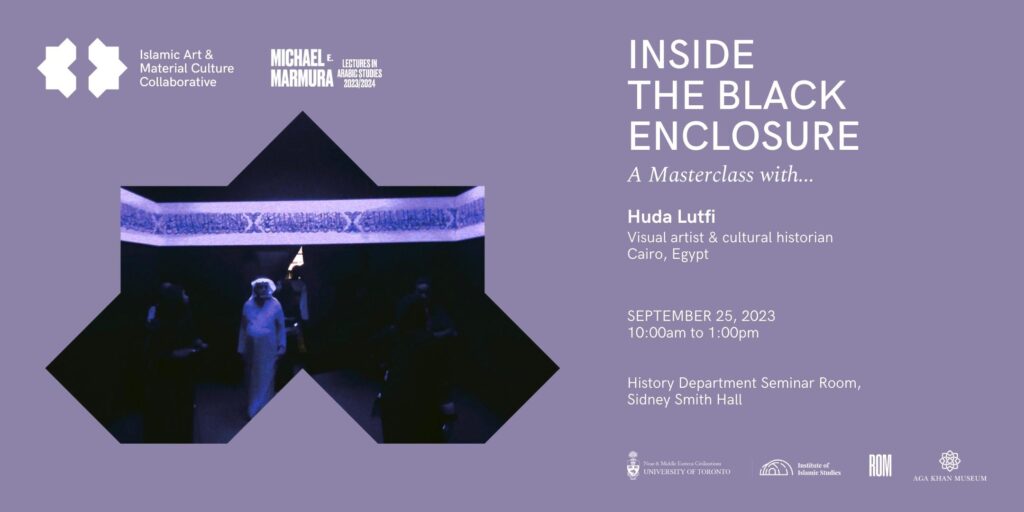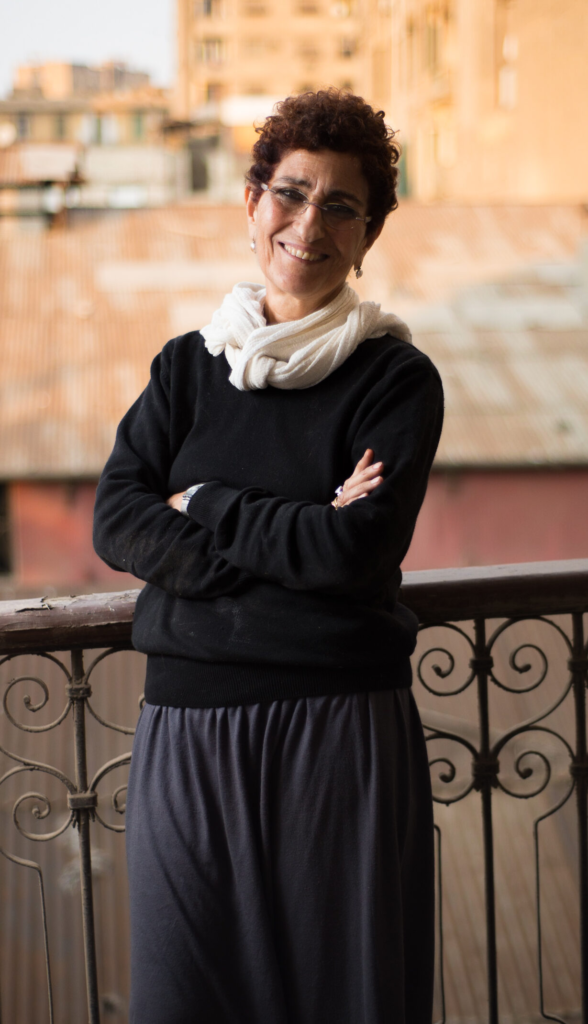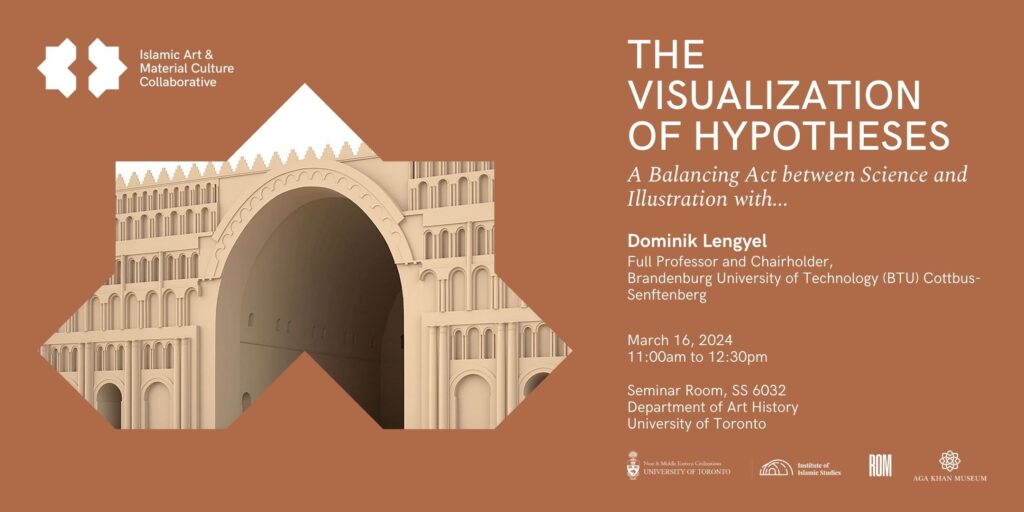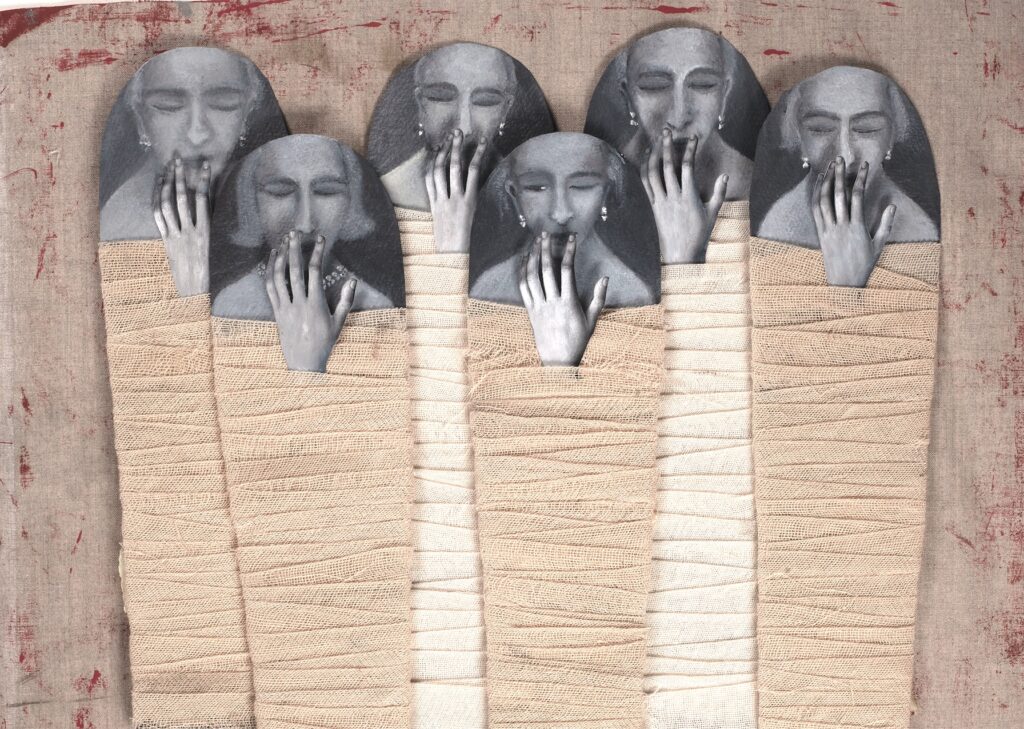[Sep 25, 2023] Inside the Black Enclosure: A Masterclass with Huda Lutfi
Event-Past
Date: Monday September 25, 2023
Time: 10am – 1pm (includes lunch for participants)
Venue: History Department Seminar Room, Sidney Smith Hall
Overview:
In this graduate masterclass, contemporary Egyptian artist Huda Lutfi will share her experiences of creating her recent installation Inside the Black Enclosure for the inaugural Islamic Arts Biennale which was held from January 23–May 23, 2023 in Jeddah, Saudi Arabia.
Lutfi will speak about the history of pilgrimage at Mecca, the importance of the kiswa covering of the ka’ba, the craftspeople involved in its making over history, and how it all connects to her recent installation. She will also discuss her artistic practice and career and problematize the notion of an Islamic Arts Biennale as part of her talk, which will also include videos of her work. Spaces are limited and attendance is by registration only. Students must complete the required readings prior to the masterclass. Lunch will be provided.
Registration & Class Prep:
Spaces are limited so attendance is by registration only and lunch will be provided. All attendees must complete the required readings prior to the masterclass and graduate students should also briefly research one of the artists in the Islamic Arts Biennale from the list provided and be prepared to speak about the artist and his/her practice for 3-5 minutes. This will allow more deeper engagement and discussion around the concept and content of the Biennale.
Masterclass Description:
Circumambulating (tawaf) the Meccan ka’ba on the first and last days of pilgrimage is an awe-inspiring act for millions of Muslim worshippers, stirring strong emotions in pilgrims’ hearts. Creating a new embellished covering for the ka’ba, the most sacred pilgrimage site in Islam, is an act of veneration that dates back to the early days of the Muslim community. As early as the Abbasid period, black became the preferred color for the covering of the ka’ba. Altered every year, this woven adornment (kiswa) is steeped in a history of craftsmanship and produced at great care and expense.
Egyptian multi-media artist Huda Lutfi’s installation, Inside the Black Enclosure, evokes this focal site of spiritual practice. Viewers are invited to walk into the inner space of a dark cubic room, illuminated only by black florescent lighting. The kiswa, meant to protect and adorn the ka’ba’s exterior while displaying the wealth and authority of its patrons, is in this instance concealed within the enclosed structure, where it serves a contemplative purpose.
Inside the enclosed darkness, all that can be seen across the black walls is a shimmering white panel on which black inscriptions are discernable. Repeatedly embroidered in a calligraphic inscription encircling the room is the Qur’anic verse affirming: To Allah belongs East and West, for wherever you turn, there is the face of Allah (walillah al-mashriq wal-maghrib fa‘aynama tuwallu fathamma wajhu Allah). As their eyes follow the inscriptions, onlookers undergo an inverted process of circumambulation, an internal tawaf that takes place within a symbolic space that resembles the venerated interior of the ka’ba, and that alludes to an individual’s inner spiritual search, with no apparent beginning or end. To enhance the immersive experience of the space, an audio element is added. As the viewers move inside the enclosure, they hear the overlapping sounds of trickling water and heart beats.
Central to both spiritual and artistic practice, the process of repetition is a vehicle to a heightened state. The viewers’ silent articulation of repeated words mirrors the meditative practice of tasbih or dhikr, drawing them into the rhythmic echo of the Qur’anic verse as they experience the artwork through their rotation around the room. A proclamation of the non-geography of worship, this Qur’anic verse brings to light a subtle but altering reminder: whether one turns eastward or westward, the truth of Allah is omnipresent.
The historical desire of powerful rulers to bestow a lavish exterior covering for the ka’ba motivated the growth of a rigorous craft practice, involving experienced artisans from Syria, Iran, Turkey, and Yemen. Long versed in the art and craft of calligraphy, weaving and embroidery, artisans based in specialized centers in Egypt were often chosen to accomplish the work required to make the kiswa.
Inside the Black Enclosure is a collaboration between the artist, Huda Lutfi, and Ahmad al-Qasabgi and his artisans to embroider the fabric panel that hangs across the walls of the constructed room. Al-Qasabgi’s grandfather served as head of dar al-kiswa (the house of al-kiswa) in Cairo, established by Muhammad Ali in the 19thcentury. For generations, members of the Qasabgi family carried the tradition of embroidering the kiswa, until the Saudi government in the first half of the 20thcentury established dar al-kiswa in Mecca in order to train its own craftsmen. The kiswa-artisans based in Cairo were known to have been involved in the transfer of this artistic knowledge to Mecca, and by the second half of the 20th century the artisans of Mecca were able to locally produce the kiswa for the ka’ba.
The Qasabgi family continues to produce religious embroideries today on a smaller scale, mostly for commercial and personal use. Commissioning them to produce the embroidered panel for this installation constituted a happy moment of return to an artistic practice they maintained for many decades. Huda Lutfi’s own practice in recent years has also evolved to include repetitive stitchwork, as she has found a rhythmic meditative practice in the craft. Her collaboration with the Qasabgi artisans links her artistic practice to a longstanding craft tradition in Egypt.
Bio:

Huda Lutfi lives and works in Cairo. She received her PhD in Arab Muslim Cultural History from McGill University in 1983. Huda’s practice has been sensitive to a loud political climate. Moving between metaphorical and literal visualizations, her work has been playful, subversive and at times equally as brutal as the conditions it reacts to. In parallel to her interest in materiality, a continuous meditative undercurrent is inspired by her early personal interest in Sufi practice. These themes of permanence, the use of repetition, and the perpetuated typologies in Lutfi’s works are compelling statements on the indiscernibility and multiplicity of our realities.


